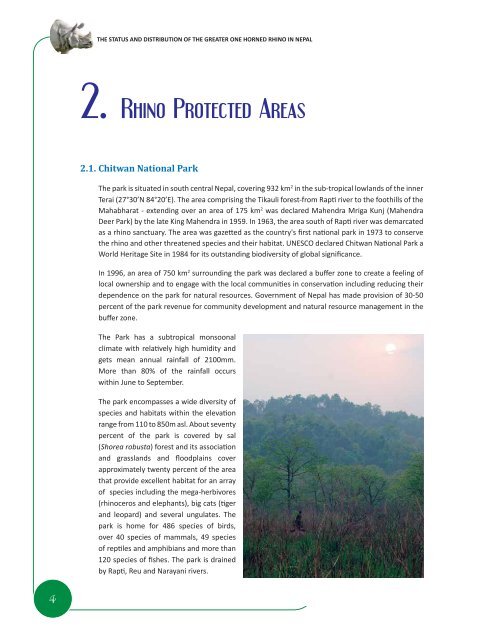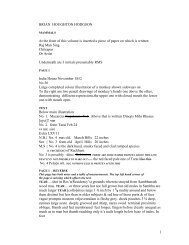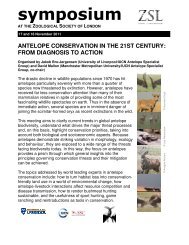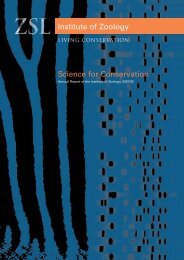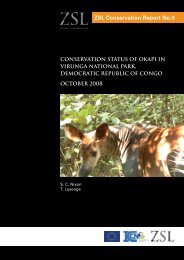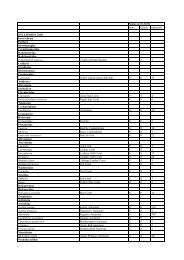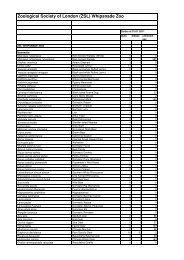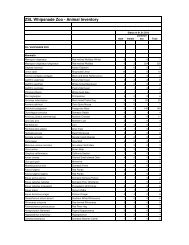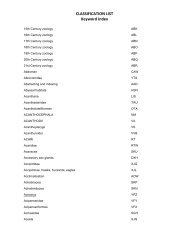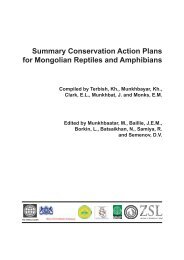the status and distribution of the greater one-horned rhino in nepal
the status and distribution of the greater one-horned rhino in nepal
the status and distribution of the greater one-horned rhino in nepal
You also want an ePaper? Increase the reach of your titles
YUMPU automatically turns print PDFs into web optimized ePapers that Google loves.
4<br />
THE STATUS AND DISTRIBUTION OF THE GREATER ONE HORNED RHINO IN NEPAL<br />
2. Rh<strong>in</strong>o Protected Areas<br />
2.1. Chitwan National Park<br />
The park is situated <strong>in</strong> south central Nepal, cover<strong>in</strong>g 932 km 2 <strong>in</strong> <strong>the</strong> sub-tropical lowl<strong>and</strong>s <strong>of</strong> <strong>the</strong> <strong>in</strong>ner<br />
Terai (27°30’N 84°20’E). The area compris<strong>in</strong>g <strong>the</strong> Tikauli forest-from Rapti river to <strong>the</strong> foothills <strong>of</strong> <strong>the</strong><br />
Mahabharat - extend<strong>in</strong>g over an area <strong>of</strong> 175 km 2 was declared Mahendra Mriga Kunj (Mahendra<br />
Deer Park) by <strong>the</strong> late K<strong>in</strong>g Mahendra <strong>in</strong> 1959. In 1963, <strong>the</strong> area south <strong>of</strong> Rapti river was demarcated<br />
as a <strong>rh<strong>in</strong>o</strong> sanctuary. The area was gazett ed as <strong>the</strong> country's fi rst nati onal park <strong>in</strong> 1973 to conserve<br />
<strong>the</strong> <strong>rh<strong>in</strong>o</strong> <strong>and</strong> o<strong>the</strong>r threatened species <strong>and</strong> <strong>the</strong>ir habitat. UNESCO declared Chitwan Nati onal Park a<br />
World Heritage Site <strong>in</strong> 1984 for its outst<strong>and</strong><strong>in</strong>g biodiversity <strong>of</strong> global signifi cance.<br />
In 1996, an area <strong>of</strong> 750 km 2 surround<strong>in</strong>g <strong>the</strong> park was declared a buff er z<strong>one</strong> to create a feel<strong>in</strong>g <strong>of</strong><br />
local ownership <strong>and</strong> to engage with <strong>the</strong> local communiti es <strong>in</strong> conservati on <strong>in</strong>clud<strong>in</strong>g reduc<strong>in</strong>g <strong>the</strong>ir<br />
dependence on <strong>the</strong> park for natural resources. Government <strong>of</strong> Nepal has made provision <strong>of</strong> 30-50<br />
percent <strong>of</strong> <strong>the</strong> park revenue for community development <strong>and</strong> natural resource management <strong>in</strong> <strong>the</strong><br />
buff er z<strong>one</strong>.<br />
The Park has a subtropical monsoonal<br />
climate with relati vely high humidity <strong>and</strong><br />
gets mean annual ra<strong>in</strong>fall <strong>of</strong> 2100mm.<br />
More than 80% <strong>of</strong> <strong>the</strong> ra<strong>in</strong>fall occurs<br />
with<strong>in</strong> June to September.<br />
The park encompasses a wide diversity <strong>of</strong><br />
species <strong>and</strong> habitats with<strong>in</strong> <strong>the</strong> elevati on<br />
range from 110 to 850m asl. About seventy<br />
percent <strong>of</strong> <strong>the</strong> park is covered by sal<br />
(Shorea robusta) forest <strong>and</strong> its associati on<br />
<strong>and</strong> grassl<strong>and</strong>s <strong>and</strong> fl oodpla<strong>in</strong>s cover<br />
approximately twenty percent <strong>of</strong> <strong>the</strong> area<br />
that provide excellent habitat for an array<br />
<strong>of</strong> species <strong>in</strong>clud<strong>in</strong>g <strong>the</strong> mega-herbivores<br />
(<strong>rh<strong>in</strong>o</strong>ceros <strong>and</strong> elephants), big cats (ti ger<br />
<strong>and</strong> leopard) <strong>and</strong> several ungulates. The<br />
park is home for 486 species <strong>of</strong> birds,<br />
over 40 species <strong>of</strong> mammals, 49 species<br />
<strong>of</strong> repti les <strong>and</strong> amphibians <strong>and</strong> more than<br />
120 species <strong>of</strong> fi shes. The park is dra<strong>in</strong>ed<br />
by Rapti , Reu <strong>and</strong> Narayani rivers.


